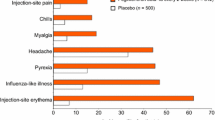Abstract
Interferon-beta (IFN-beta) therapy for multiple sclerosis (MS) is associated with a potential for induction of neutralizing antibodies (NAbs). Because immune reactivity depends on changes in lipoprotein metabolism, we investigated whether plasma lipoprotein profiles could be associated with the development of NAbs. Thirty-one female MS patients treated with subcutaneously administered IFN-beta were included. Demographic and clinical characteristics were compared between NAbs response groups using t tests for continuous and logistic regression analysis and Fisher’s exact tests for categorical data, respectively. Multivariate logistic regression was used to evaluate the effect of potential confounders. Patients who developed NAbs had lower apoE levels before treatment, 67 (47–74) mg/L median (interquartile range), and at the moment of NAb analysis, 53 (50–84) mg/L, in comparison to those who remained NAb-negative, 83 (68–107) mg/L, P = 0.03, and 76 (66–87) mg/L, P = 0.04, respectively. When adjusting for age and smoking for a one-standard deviation decrease in apoE levels, a 5.6-fold increase in the odds of becoming NAb-positive was detected: odds ratios (OR) 0.18 (95% CI 0.04–0.77), P = 0.04. When adjusting for apoE, smoking habit became associated with NAb induction: OR 5.6 (95% CI 1.3–87), P = 0.03. These results suggest that apoE-containing lipoprotein metabolism and, possibly, tobacco smoking may be associated with risk of NAb production in female MS patients treated with IFN-beta.
Similar content being viewed by others
References
Hartung HP, Polman C, Bertolotto A et al (2007) Neutralising antibodies to interferon β in multiple sclerosis: expert panel report. J Neurol 254:827–837
Bendtzen K, Kromminga A (2008) Immunogenicity of interferon-beta. In: van de Weert M, Moller EH (eds) Biotechnology: pharmaceutical aspects vol VIII. Immunogenicity of biopharmaceuticals. Springer, New York, pp 127–136
Hoffmann S, Cepok S, Grummel V et al (2008) HLA-DRB1*0401 and HLA-DRB1 *0408 are strongly associated with the development of antibodies against interferon-β therapy in multiple sclerosis. Am J Hum Genet 83:219–227
Gilli F, Valentino P, Caldano M (2008) Expression and regulation of IFNalpha/beta receptor in IFNbeta-treated patients with multiple sclerosis. Neurology 71:1940–1947
Lo JC, Wang Y, Tumanov AV et al (2007) Lymphotoxin alpha receptor-dependent control of lipid homeostasis. Science 316:285–288
Getz SG, Reardon CA (2009) Apoprotein E as a lipid transport and signalling protein in the blood, liver, and artery wall. J Lipid Res S156–S161
Giubilei F, Antonini G, De Legges S et al (2002) Blood cholesterol and MRI activity in first episode suggestive of multiple sclerosis. Acta Neurol Scand 106:109–112
Jamroz-Wisniewska A, Beltowski J, Stelmasiak Z, Bartosik-Psujek H (2009) Paraoxonase 1 activity in different types of multiple sclerosis. Mult Scler 15:399–402
McDonald WI, Compston A, Edan G et al (2001) Recommended diagnostic criteria for multiple sclerosis: guidelines from the international panel on diagnosis of multiple sclerosis. Ann Neurol 50:121–127
Kurtzke JF (1983) Rating neurological impairment in multiple sclerosis: an expanded disability status scale (EDSS). Neurology 33:1444–1452
Roxburgh RH, Seaman SR, Masterman T et al (2005) Multiple sclerosis severity score: using disability and disease duration to rate disease severity. Neurology 64:1144–1151
Rio J, Nos C, Tintoré M et al (2006) Defining the response to interferon-beta in relapsing-remitting multiple sclerosis patients. Ann Neurol 59:344–352
Sorensen PS, Ross C, Clemmesen KM et al (2003) Clinical importance of neutralising antibodies against interferon beta in patients with relapsing-remitting multiple sclerosis. Lancet 362:1184–1191
Friedewald WT, Levy RI, Fredrickson DS (1972) Estimation of the concentration of low-density lipoprotein cholesterol in plasma, without use of the preparative ultracentrifuge. Clin Chem 18:499–502
Sena A, Couderc Ferret-SenaV et al (2009) Apolipoprotein E polymorphism interacts with cigarette smoking in progression of multiple sclerosis. Eur J Neurol l16:832–837
Comabella M, Lunemann JD, Rio J et al (2009) A type I interferon signature in monocytes associated with poor response to interferon-beta in multiple sclerosis. Brain 132:3353–3365
Carlsson J, Armstrong VW, Reiber H et al (1991) Clinical relevance of the quantification of apolipoprotein E in cerebrospinal fluid. Clin Chem Acta 196:167–176
Feng-Qiao L, Sempowski GD, McKenna SE et al (2006) Apolipoprotein E-derived peptides ameliorate clinical disability and inflammatory infiltrates into the spinal cord in murine model of multiple sclerosis. J Pharmacol Exp Ther 318:956–965
Li L, Thompson PA, Kitchens RL (2008) Infection induces a positive acute phase apolipoprotein E response from a negative acute phase gene: role of hepatic LDL receptors. J Lipid Res 49:1782–1793
Garg N, Weinstock-Guttman B, Bhasi K, Locke J, Ramanathan M (2007) An association between autoreactive antibodies and anti-interferon-β antibodies in multiple sclerosis. Mult Scler 13:895–899
Sena A, Pedrosa R, Graça Morais M (2004) Statins for multiple sclerosis. Lancet 364:412
Sapori M (2002) Effects of cigarette smoke on the immune system. Nat Rev Immunol 2:372–377
Acknowledgments
We thank nurses Cristina Araújo and Ana Mendes, and Mrs Firmina Lebre and Augusta Marques for help in research. We are also grateful to BioEPI, Clinical and Translational Research Centre, for assistance in statistical analysis by Dr. Joana Vasconcelos and for epidemiological revision by Dr. Elizabeth Benito-Garcia. This work was supported by a grant from Biogen idec Portugal (RECONVERT project).
Author information
Authors and Affiliations
Corresponding author
Rights and permissions
About this article
Cite this article
Sena, A., Bendtzen, K., Cascais, M.J. et al. Influence of apolipoprotein E plasma levels and tobacco smoking on the induction of neutralising antibodies to interferon-beta. J Neurol 257, 1703–1707 (2010). https://doi.org/10.1007/s00415-010-5606-4
Received:
Revised:
Accepted:
Published:
Issue Date:
DOI: https://doi.org/10.1007/s00415-010-5606-4




